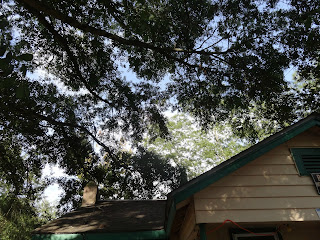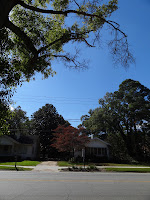Board Members Present: Brenda Douce, Joe Laforest, Danny McLaren [ex-officio], Al Potts, and Jeannie Rigdon.
Visitors Present: Dr. David Bridges [President of ABAC], Roger C. Dill [President ABAC Foundation], Duncan McClusky, Melvin L. Merrill [ABAC Foundation], Ashley Mock [ABAC Public Relations Director], and Michael Murphy [arborist].
TIFTS TREES
Al Potts has posted a message on the blog. Joe Laforest may post the meeting notes to the blog.
TIFTON CODES
The current codes are being reviewed and this board may be provided an opportunity to list trees that should be used around newly constructed buildings.
BOARD BYLAWS
Larry Riner has requested a copy of the Tree Board Bylaws. No one present knew of any bylaws for the board. There is a section in the city codes about the board.
TREES
The oak tree in front of the zero energy house needs removal.
Plans are being formulated to enlarge the Fulwood Park playground and some trees will need to be removed.
ABAC HISTORY
The majority of the meeting was utilized to discuss landscape plans for the ABAC Campus.
ABAC started in 1906 when legislation set up a mechanical and agricultural high school. The Second Congressional District A &M School opened in February 1908. Three of the four original campus buildings are still standing in the front of the campus. Lewis Hall and Herring Hall were closed in the 1980’s and Tift Hall was closed in 2007. The historic front of the campus is being restored to its early beginnings and Tift Hall was opened again last week. The first floor of the Tift Building will essentially be a museum presenting the history of the campus. $17 million has been spent on restorations. The state has been generous and one reason for the generosity may be the three original buildings.
RESTORATION STUDY
Several years ago Pratt Cassity from the UGA College of Environment and Design visited the campus with several graduate students. They evaluated the campus and held town hall meetings to work on a design for the campus. In the process all the trees and vegetation on campus was reviewed. There were green spaces on campus. Behind the three original buildings there are green areas with a wavy line of plants at the end of the open spaces. This landscaping was considered in the campus plan.
FRONT LAWN
A parking lot was put in front of the three buildings at some point in history. The plans are to remove the majority of the parking in the front of the buildings. A berm will hide the few parking spaces that would be left in the front of the campus. The sightline coming down the RDC Road will be of the buildings and the flag pole is on top of the Tift Building. There will be a grand front lawn in front of the campus. This front lawn will provide space for an outdoor graduation ceremony or to host other events.
The lawn nearest Moore Highway will be Tiftblair Centipede Grass which was developed by Dr. Wayne Hanna. The next turf will be Tifgrand Bermuda grass which is a sports field turf that is shade tolerant. Closest to the campus will be an Emerald Zoysia grass separated by granite appearing concrete. All three grasses were developed by the University of Georgia Tifton Campus.
This fall rye grass will be planted in front of the buildings. Trees will be planted in the winter and in late spring the permanent grasses will be planted.
Live Oak trees will be selected for the front as well.
RDC ROAD
In the 1980’s plans were set up to make the RDC Road a four lane road. The land was graded but due to funding the work was never completed. The other two lanes will be added with a 15 foot wide median in between. The median will be city right of way land. The Department of Transportation and the City of Tifton will fund the widening of this road. This will be a beautiful approach to the ABAC Campus, the UGA Tifton Campus and to the UGA Conference Center. One signature is needed from the railroad before this work can begin.
There was some discussion about providing water to the median and what plants would be planted in this area. There are no current landscaping plans for this area.
TREE EVALUATION
Mr. Murphy, a certified arborist, has been working on campus for over two years. Mr. Murphy has worked with trees in the cities of Charleston and Savannah. He has studied oak trees over the past 18 years. He has found many of the laurel and water oak trees on the ABAC Campus are hollow and need to be removed.
There are palm trees in the front of campus and these may have been planted as part of the original campus. These trees will stay. There is a black walnut tree in front of the nursing building and it is the only black walnut tree on campus so it will remain.
Safety is a primary concern for the landscaping work. Trees that need to be removed will be done by people experienced in this work.
All vegetation on campus has been mapped and plotted with GIS. The landscaping plan has been developed for the campus to show what plants will be planted where. Plants that are not wanted will be removed. There are a couple large crape myrtle trees on campus that may be left from the original campus and they will remain.
SUSTAINABILITY
There was a question regarding the sustainability of the landscaping. Two offices, one in Tallahassee and one in South Carolina will work on the pruning. Melvin Merrill will have a maintenance plan to follow. The idea is to use low maintenance plants. Mr. Murphy will be available to contract with if the need arises.
ABAC STRATEGIC PLAN
The last five year campus strategic plan was completed in 2007 and is in the process of running out now. The key component of this plan was to make the college a place that students would choose to attend. The campus appeal was important. There have been vast improvements in the grounds. A lot of resources have gone into the campus.
PARKING LOTS
The campus has large open parking lots. It is not a capital investment priority to have these parking lots redone with vegetative areas.
TREES FOR FRONT
The trees in front need to be uniform and to come from nursery stock.
TREE CAMPUS
The Georgia Forestry Commission will be reviewing campuses for Tree Campus Certification and this requires students to be involved in the work. The removal of trees is a liability and safety issue so it won’t be good for students to be involved in this work.
MANAGEMENT
All work is being coordinated through the Physical Plant and it is being planned to minimize disruptions to the campus. J. T. Turner Construction Co. from Savannah, Georgia and another company [Greenline ?] are handling the work.
GIS DATABASE
The ABAC Campus has a 20+ layer GIS database locating utilities, buildings, and trees on campus. The campus is moving to make this information available on a mobile platform. Joe Laforest suggested tying the city Tree Keeper software with the ABAC system.
DITCH
There is a ditch on Moore Highway near the nursing building. It is parallel and perpendicular to the road and seems to be getting worse. Some thought is being given on how to deal with this.
UNIVERSITY SYSTEM OF GEORGIA TREE FOUNDATION
The University of Georgia manages a program for the University System of Georgia to access donated plants from various nurseries in the state. ABAC can access this database and request free plants.
WOOD
The wood from the trees that are cut down will be evaluated. Some will be cut up for firewood to be used by the Georgia Museum of Agriculture. Some will be mulched and left to decay before use on campus. The campus will salvage what they can. Joe Laforest suggested contacting turners who might want to use the wood.
MEMORIAL TREES
The ABAC Campus doesn’t plant memorial trees anymore.
The discussion about the ABAC landscaping plans ended and the Tree Board discussed another issue.
ARBOR DAY
Jeannie Rigdon suggested holding a community tree planting event for Arbor Day where a large number of trees would be planted. There was some discussion about where to plant the trees, paying for locates to mark underground utilities, and how large the event could be. There was also a concern about paying for the event. A 3.5 inch oak tree costs $150 apiece.
One suggestion was to talk to various civic groups to see how many would participate in the event. Then to have one tree to plant for each group. Another idea was to talk to homeowners along selected streets and see if they would agree to adopt a tree planted in the right of way in front of their house.
TREE DAMAGE
Can the city put in a code indicating that anyone damaging or removing a right of way tree would be penalized? People would express their views on this code to the code enforcement officers and not to the Tree Board.












































